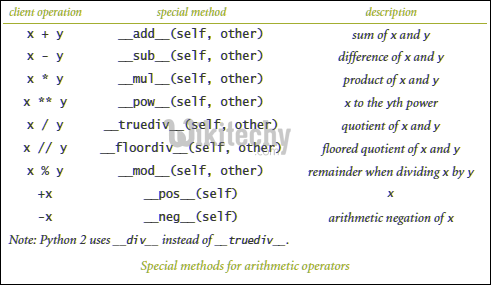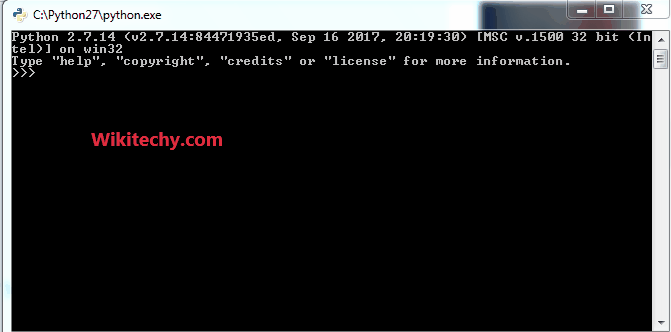Python has predefined functions for many mathematical, logical, relational, bitwise etc operations under the module “operator”.
1. add(a, b) :- This functions returns addition of the given arguments.
Operation – a + b.
2. sub(a, b) :- This functions returns difference of the given arguments.
Operation – a – b.
3. mul(a, b) :- This functions returns product of the given arguments.
Operation – a * b.

python - Sample - python code :
# Python code to demonstrate working of
# add(), sub(), mul()
# importing operator module
import operator
# Initializing variables
a = 4
b = 3
# using add() to add two numbers
print ("The addition of numbers is :",end="");
print (operator.add(a, b))
# using sub() to subtract two numbers
print ("The difference of numbers is :",end="");
print (operator.sub(a, b))
# using mul() to multiply two numbers
print ("The product of numbers is :",end="");
print (operator.mul(a, b))
Learn Python - Python tutorial - python operatorfun - Python examples - Python programs
python tutorial - Output :
The addition of numbers is :7 The difference of numbers is :1 The product of numbers is :12
4. truediv(a,b) :- This functions returns division of the given arguments.
Operation – a / b.
5. floordiv(a,b) :- This functions also returns division of the given arguments. But the value is floored value i.e. returns greatest small integer.
Operation – a // b.
6. pow(a,b) :- This functions returns exponentiation of the given arguments.
Operation – a ** b.
7. mod(a,b) :- This functions returns modulus of the given arguments.
Operation – a % b.
python - Sample - python code :
# Python code to demonstrate working of
# truediv(), floordiv(), pow(), mod()
# importing operator module
import operator
# Initializing variables
a = 5
b = 2
# using truediv() to divide two numbers
print ("The true division of numbers is : ",end="");
print (operator.truediv(a,b))
# using floordiv() to divide two numbers
print ("The floor division of numbers is : ",end="");
print (operator.floordiv(a,b))
# using pow() to exponentiate two numbers
print ("The exponentiation of numbers is : ",end="");
print (operator.pow(a,b))
# using mod() to take modulus of two numbers
print ("The modulus of numbers is : ",end="");
print (operator.mod(a,b))python tutorial - Output :
The true division of numbers is : 2.5 The floor division of numbers is : 2 The exponentiation of numbers is : 25 The modulus of numbers is : 1
8. lt(a, b) :- This function is used to check if a is less than b or not. Returns true if a is less than b, else returns false.
Operation – a < b.
9. le(a, b) :- This function is used to check if a is less than or equal to b or not. Returns true if a is less than or equal to b, else returns false.
Operation – a <= b.
10. eq(a, b) :- This function is used to check if a is equal to b or not. Returns true if a is equal to b, else returns false.
Operation – a == b.
python - Sample - python code :
# Python code to demonstrate working of
# lt(), le() and eq()
# importing operator module
import operator
# Initializing variables
a = 3
b = 3
# using lt() to check if a is less than b
if(operator.lt(a,b)):
print ("3 is less than 3")
else : print ("3 is not less than 3")
# using le() to check if a is less than or equal to b
if(operator.le(a,b)):
print ("3 is less than or equal to 3")
else : print ("3 is not less than or equal to 3")
# using eq() to check if a is equal to b
if (operator.eq(a,b)):
print ("3 is equal to 3")
else : print ("3 is not equal to 3")python tutorial - Output :
3 is not less than 3 3 is less than or equal to 3 3 is equal to 3
11. gt(a,b) :- This function is used to check if a is greater than b or not. Returns true if a is greater than b, else returns false.
Operation – a > b.
12. ge(a,b) :- This function is used to check if a is greater than or equal to b or not. Returns true if a is greater than or equal to b, else returns false.
Operation – a >= b.
13. ne(a,b) :- This function is used to check if a is not equal to b or is equal. Returns true if a is not equal to b, else returns false.
Operation – a != b.
python - Sample - python code :
# Python code to demonstrate working of
# gt(), ge() and ne()
# importing operator module
import operator
# Initializing variables
a = 4
b = 3
# using gt() to check if a is greater than b
if (operator.gt(a,b)):
print ("4 is greater than 3")
else : print ("4 is not greater than 3")
# using ge() to check if a is greater than or equal to b
if (operator.ge(a,b)):
print ("4 is greater than or equal to 3")
else : print ("4 is not greater than or equal to 3")
# using ne() to check if a is not equal to b
if (operator.ne(a,b)):
print ("4 is not equal to 3")
else : print ("4 is equal to 3")python tutorial - Output :
4 is greater than 3 4 is greater than or equal to 3 4 is not equal to 3
